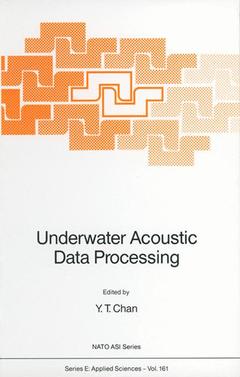Description
Underwater Acoustic Data Processing, Softcover reprint of the original 1st ed. 1989
NATO Science Series E: Series, Vol. 161
Coordinator: Chan Y. T.
Language: English
Subjects for Underwater Acoustic Data Processing:
Publication date: 02-2012
674 p. · 15.5x23.5 cm · Paperback
674 p. · 15.5x23.5 cm · Paperback
Description
/li>Contents
/li>
This book contains the papers that were accepted for presentation at the 1988 NATO Advanced Study Institute on Underwater Acoustic Data Processing, held at the Royal Military College of Canada from 18 to 29 July, 1988. Approximately 110 participants from various NATO countries were in attendance during this two week period. Their research interests range from underwater acoustics to signal processing and computer science; some are renowned scientists and some are recent Ph.D. graduates. The purpose of the ASI was to provide an authoritative summing up of the various research activities related to sonar technology. The exposition on each subject began with one or two tutorials prepared by invited lecturers, followed by research papers which provided indications of the state of development in that specific area. I have broadly classified the papers into three sections under the titles of I. Propagation and Noise, II. Signal Processing and III. Post Processing. The reader will find in Section I papers on low frequency acoustic sources and effects of the medium on underwater acoustic propagation. Problems such as coherence loss due to boundary interaction, wavefront distortion and multipath transmission were addressed. Besides the medium, corrupting noise sources also have a strong influence on the performance of a sonar system and several researchers described methods of modeling these sources.
I Propagation and Noise.- Fundamentals of bistatic active sonar.- Sources of low-frequency sound in the sea.- Application of the output error system identification method to the calibration of underwater acoustic transducers.- Low frequency sector scanner using NLA.- Acoustic coherence loss due to ocean boundary interactions.- Advanced methods for the investigation of the underwater channel.- A new algorithm for the identification of distorted wavefronts.- The multipath coherence function for correlated random channels and a moving source.- Vertical directionality of ambient noise at 32°N as a function of longitude and wind speed.- The influence of bubbles on acoustic propagation and scattering.- In-situ measurement of elastic properties of sea ice.- Generalized mixture noise models for U. W. A..- Some aspects of sound propagation in shallow water: estimation of source and sound channel parameters.- Mediterranean underwater ambient noise model.- Determination of the acoustic properties of the sea floor by measuring the angle dependency of the reflection coefficient.- The influence of random thermocline displacements on shallow water transmission loss.- A review of target strength estimation techniques.- Near field target strength measurements.- Efficient processing and displaying of active systems data.- Performance of incoherent pulse compression of costas signals.- A numerical and analytical approach for pulse propagation in refracting and random media.- II Signal Processing.- Future trends in sonar signal processing.- Active and passive localization: similarities and differences.- State estimation of moving active targets by reverberation analysis.- Signal processing in the linear statistical model.- Parameter estimation of signals corrupted by noise using a matrix of divided differences.- Factor analysis and estimation of covariance matrix.- Rayleigh estimates for high resolution direction finding.- High discrimination target detection algorithms and estimation of parameters.- Parametric methods for estimation of signals and noise in wavefields.- Enhanced minimum variance beamforming.- Optimal estimation and beamforming.- Adaptive processing of broadband acoustic signals.- Beamforming on linear antennas with optical processors.- Adaptive methods in temporal processing.- Passive array processing: from conventional to high resolution concepts.- Beamforming in the presence of correlated arrivals.- High-resolution spatial processing with short observation times.- Estimation for array processing of spatial noise correlations in the presence of sources.- Spatial array processing by the method CLEAN.- A robust adaptive array structure using the soft constrained LMS algorithm.- Design and development of an acoustic antenna system for industrial noise source identification.- A small aperture acoustic direction finder.- Inverse problems: a tutorial survey.- Applied modelling to underwater vehicles identification.- The effect of mismatch on array processors with normal mode replica vectors.- Robust beamforming for matched field processing under realistic environmental conditions.- Threshold extension by nonlinear techniques.- Application of acoustics in the land environment.- Systolic array implementation of parallel Kalman filtering for heave compensation in underwater acoustic data processing.- TMA performance for towed arrays of low manoeuvrability.- Multi-tracks association for underwater passive listening.- New observability criterion in target motion analysis.- Bearings only target motion analysis.- Models for the application of Kalman filtering to the estimation of the shape of a towed array.- Frequency line tracking algorithms.- Localization of far-field sources with an array of unknown geometry.- Passive localization.- Inter-array data association and target motion analysis.- Joint delay and signal determination.- III Post Processing.- Use of multicolor displays for sonar detection.- Artificial intelligence and signal understanding.- An artificial intelligence approach to multipath localization and tracking.- 3D reconstruction and recognition from multiple views and with different acquisition constraints.- Expert system applications in underwater acoustics.- Classification of ships using underwater radiated noise.- Practical experience gained during the building of an expert system for the interpretation of underwater signals.- Knowledge-based interpretation of passive sonar data.- “Constant capacity,” DSP architecture — an historical perspective.- Parallel computing you can do.- Practical graph partitioning algorithms for SONAR.- Concurrency in digital signal processing.- An experimental sonar system using transputers.- Summaries of Workshops.
© 2024 LAVOISIER S.A.S.




